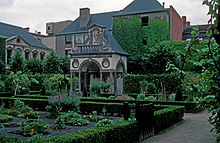6:32 PM Peter Paul Rubens | ||||||||||||||||
Peter Paul Rubens
"Rubens"
Contents================================================================= Biography==The garden Rubens planned at Rubenshuis, in Antwerpen
Early lifeRubens was born in the German city of Siegen, Nassau-Dillenburg, to Jan Rubens and Maria Pypelincks. His father, a Calvinist, and mother fled Antwerp for Cologne in 1568, after increased religious turmoil and persecution of Protestants during the rule of the Spanish Netherlands by the Duke of Alba. Jan Rubens became the legal advisor (and lover) of Anna of Saxony, the second wife of William I of Orange, and settled at her court in Siegen in 1570, fathering her daughter Christine who was born in 1571.[2] Following Jan Rubens' imprisonment for the affair, Peter Paul Rubens was born in 1577. The family returned to Cologne the next year. In 1589, two years after his father's death, Rubens moved with his mother Maria Pypelincks to Antwerp, where he was raised as a Catholic. Religion figured prominently in much of his work and Rubens later became one of the leading voices of the Catholic Counter-Reformation style of painting[3] (he had said "My passion comes from the heavens, not from earthly musings").
Sir Peter Paul Rubens (/ˈruːbənz/;[1] Dutch: [ˈrybəns]; 28 June 1577 – 30 May 1640) was a Flemish Baroque painter. A proponent of an extravagant Baroque style that emphasized movement, colour, and sensuality, Rubens is well known for his Counter-Reformation altarpieces, portraits, landscapes, and history paintings of mythological and allegorical subjects. In addition to running a large studio in Antwerp that produced paintings popular with nobility and art collectors throughout Europe, Rubens was a classically educated humanist scholar and diplomat who was knighted by both Philip IV, King of Spain, and Charles I, King of England.
| ||||||||||||||||
|
| ||||||||||||||||
| Total comments: 0 | |



